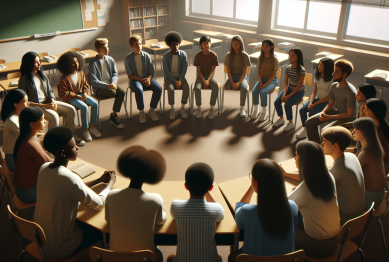Resolving conflict with empathy is essential in today’s classrooms, workplaces, and communities. When we lead with understanding rather than judgment, we build stronger relationships, reduce tension, and create lasting solutions. As emotional intelligence and cultural awareness grow in importance, using empathy becomes a vital part of modern conflict resolution.

Why Resolving Conflict with Empathy Matters
In today’s hyper-connected world, conflict spreads quickly—whether through misinterpreted emails, classroom debates on identity, or friction in hybrid teams. The way we resolve disagreements directly impacts performance, relationships, and community trust.
A 2023 CPP Global report found that unresolved conflict costs organizations an average of 2.8 hours per employee per week in lost productivity. In schools, unmanaged conflict is tied to lower academic achievement and higher dropout rates (National Center for Safe Supportive Learning Environments, 2022).
Core Principles for Resolving Conflict with Empathy
1. Focus on Interests, Not Positions
Ask why, not just what. This foundational strategy from the Harvard Negotiation Project encourages parties to explore underlying needs rather than fixed demands.
2. Active Listening and Reflective Feedback
Truly listening—with the intent to understand rather than to reply—can diffuse defensiveness and signal respect. Reflective feedback (“What I hear you saying is…”) confirms understanding.
3. Psychological Safety
People need to feel safe to express disagreement. Without that foundation, resolution efforts may be performative or one-sided. Establish norms of respectful dialogue.
Empathy in Action: Conflict Resolution Across Different Spaces
1. Resolving Conflict with Empathy in Education
More schools are adopting restorative justice to address conflict, especially among students. Instead of suspensions or detentions, restorative circles encourage students to:
- Speak openly about harm
- Acknowledge responsibility
- Repair trust through structured dialogue
A study by RAND Corporation found that schools implementing restorative practices saw reduced suspensions and improved school climate (RAND, 2021).
2. Resolving Conflict with Empathy in Hybrid Workplaces
Remote work has introduced new tensions—miscommunication via chat, lack of informal resolution opportunities, and digital silence. Conflict resolution now requires:
- Virtual mediation tools
- Camera-on policies for sensitive discussions
- Asynchronous feedback systems to ensure all voices are heard
Platforms like Bravely and LifeLabs Learning are developing tools for real-time, remote conflict navigation.
3. Inclusive Conflict Resolution Through Empathy
Modern conflicts often intersect with identity—race, gender, neurodiversity, and power dynamics. Inclusive conflict resolution means:
- Recognizing systemic patterns
- Training facilitators in cultural humility
- Allowing space for historically marginalized voices
This trend is being adopted in universities, HR departments, and nonprofit organizations worldwide.
Practical Strategies for Resolving Conflict with Empathy
Strategy 1: Set Ground Rules for Effective Conflict Resolution
Preventative groundwork can reduce escalation. Teams should co-create agreements around:
- How to raise concerns
- What respectful disagreement looks like
- When to involve a third party
Strategy 2: Use the “Yes, and…” Technique
Borrowed from improv, this method avoids invalidating the other person’s perspective. Instead of “No, but…”, say “Yes, and…” to build momentum toward a shared solution.
Strategy 3: Apply the S.T.O.P. Method for Self-Regulation
When emotions spike:
- S: Stop and pause
- T: Take a breath
- O: Observe your thoughts and feelings
- P: Proceed with intention
This technique is widely used in emotional intelligence coaching and conflict de-escalation training.
Strategy 4: Use Mediators for Structured Conflict Resolution
Not every conflict can be solved internally. A neutral third party can:
- Maintain balance
- Facilitate structure
- Guide the conversation toward outcomes
This is especially critical in education settings or workplaces where power imbalances exist.
Conflict Resolution in Action: Real-World Examples
In Schools: Peer Mediation Programs
Programs like Peace First and Teen Court train students to mediate peer disputes. The results? Lower incidents of repeat conflict and improved student confidence in problem-solving.
In Workplaces: Structured Feedback Systems
Companies like Adobe have replaced traditional performance reviews with check-in models—frequent, informal feedback sessions that help surface and resolve tensions early.
In Communities: Police and Community Dialogue Circles
Cities like Oakland, CA, are using community-based dialogue programs to rebuild trust between law enforcement and residents. These forums often follow restorative principles.
What to Avoid in Conflict Resolution
- Avoiding the issue: Silence and avoidance often escalate problems.
- Assuming intent: Clarify before interpreting someone’s motivations.
- Public shaming: Conflicts resolved privately protect dignity and encourage accountability.
- Overusing apology without action: True resolution includes change, not just remorse.
Final Thoughts
Conflict is unavoidable, but chaos is not. Practicing effective conflict resolution isn’t about avoiding hard conversations—it’s about building the tools and cultures to handle them well.
From schools teaching empathy in classrooms to companies rewriting feedback policies, how we manage disagreement is quickly becoming a core metric of success in education and society.
References:
- CPP Global (2023) Workplace Conflict and How Businesses Can Harness It. https://shop.themyersbriggs.com/Pdfs/CPP_Global_Human_Capital_Report_Workplace_Conflict.pdf (Accessed: 2 June 2025).
- RAND Corporation (2021) Restorative Practices and Student Outcomes. https://www.rand.org/pubs/commentary/2019/01/the-impact-of-restorative-practices.html (Accessed: 2 June 2025).
- National Center for Safe Supportive Learning Environments (2022) The Impact of Conflict in Schools. https://www.frontiersin.org/articles/10.3389/feduc.2020.00005/full (Accessed: 2 June 2025).









